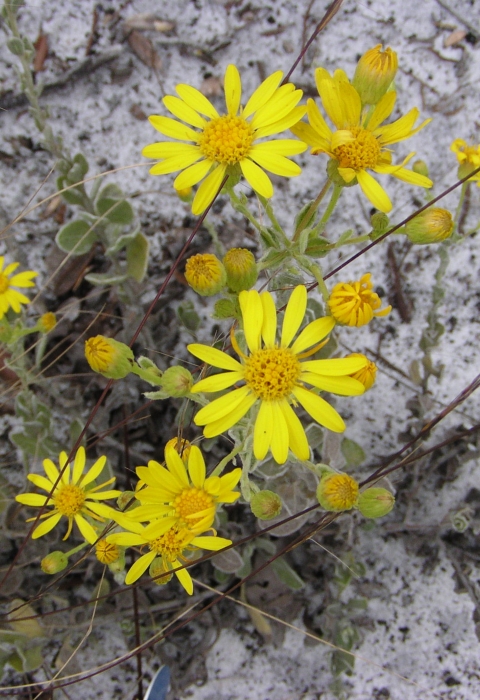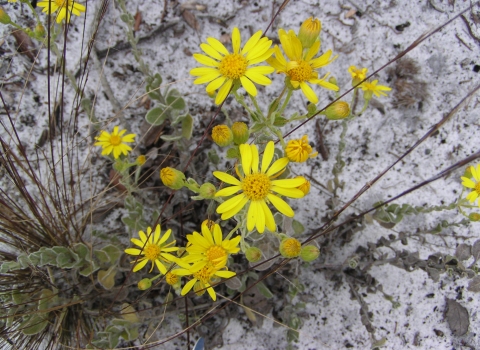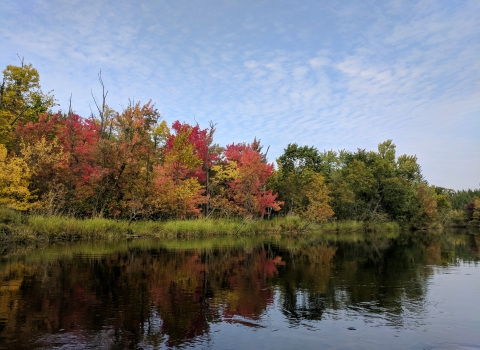A member of the daisy family, Florida golden aster’s small but bright yellow petals erupt from its yellow pistil center like a starburst sitting atop hairy, silver-green leaves. This plant, native to five counties in west central Florida around the Tampa Bay area, was listed as endangered in 1986. But thanks to the efforts of the U.S. Fish and Wildlife Service and its partners, the aster is an Endangered Species Act success story.
The Florida golden aster’s habitat was mostly converted to urban development and agricultural uses. However, the Service, Florida Department of Environmental Protection and county natural resource managers worked to acquire land to propagate and reintroduce plants into new populations. In 1986, when the aster was listed under the ESA, only nine clusters of the wildflower could be found growing in Hillsborough County, Florida. Today, 37 years later, 30 populations have spread across five counties east and southeast of the Tampa Bay area in west central Florida.
We recently celebrated the 50th anniversary of the Endangered Species Act, and the recovery of the Florida golden aster is another victory to celebrate its effectiveness. The ESA has provided a critical safety net for fish, wildlife and plants and has prevented the extinction of hundreds of imperiled species, as well as promoted the recovery of many others, and conserved the habitats upon which they depend. Conserving the aster’s open, sandy scrub habitat is essential for its survival.
“The Florida golden aster depends on open spaces within the scrub habitat to thrive,” said Todd Mecklenborg, Service biologist in St. Petersburg, Florida. “If you don’t have enough fire or habitat management to maintain the openness, the vegetation becomes overgrown resulting in a closed tree canopy and a dense understory, and the species does not do well,” he added.
The Work Begins
As conservation lands were acquired by state, county, and city entities, a multidisciplinary team from the Service’s Project Review Section, Partners for Fish and Wildlife, and Coastal Programs, worked for decades to assist in Florida golden aster’s recovery. By introducing plants onto conservation lands, the number of populations began to increase range-wide. Mecklenborg also credited working with several partners from various agencies across the region on plant introductions on their conservation lands and performing the analysis, propagation, and demography studies.
The early introduction efforts occurred in Hillsborough and Pinellas counties from 1986-1989. Between 2008 and 2013, plants were being propagated and introduced throughout its historic range on state and county conservation lands. “We did a couple of really large introductions in Manatee County on a water district property,” Mecklenborg recounted. In 2011, they did additional introductions at Paynes Creek Park in Hardee County. The last biggest push was the introduction on a preserve in Manatee County in 2013.
Propagating Asters
The propagation and introduction process starts with collecting seeds from the plants in late December through early February. This is done by placing bags over its flowers. The seeds are then grown in a plant nursery until they are large enough to plant in the wild. Numerous teams from a variety of agencies planted them, watered them for several weeks, then monitored them for several years. Planting typically took place in the summer. Sometimes, a water truck brought in water to help acclimate the plants until the wet season came.
“We'd go back year after year after year and for a number of years, just to watch how they were doing,” Mecklenborg explained. “Some populations did very well, some populations came and went, some populations fluctuated. It just depended on our efforts and how large of an effort or how much effort, or did we pick the right soils to put them in? Did we have the right habitat? Was there enough management – things like that,” he said.
The Road to Delisting
After a five-year review conducted in 2009 recommended reclassifying the species to threatened, the Florida golden aster was proposed for removal from the Federal List of Endangered and Threatened Plants due to recovery in June 2021, indicating the threats to the species had been reduced or eliminated. A post-delisting monitoring plan was drafted to ensure its stability after delisting. After 37 long years of habitat acquisition and management, today we celebrate its recovery. The Florida golden aster will be removed from protections under the ESA – a delisting due to recovery.
Since its enactment in 1973, the ESA has prevented the extinction of hundreds of species. It’s clear that saving a species from extinction doesn’t happen overnight, but the years of work done on behalf of the Florida golden aster have shown that visionary, innovative, and determined actions taken by Service team members and our partners contribute daily to the success of the ESA.
“It's a pretty typical scrub plant - a component of that landscape – and not even super flashy. It's not what we call a monotypic species that covers a big area – it's just a component within,” said Mecklenborg. And that’s just the point. Each species has its place in the landscape, part of the web of life. Even if we don’t notice them or know what role they play, the ESA has helped us preserve that importance for more than just an unassuming little aster in the sandy wilds of Florida.




